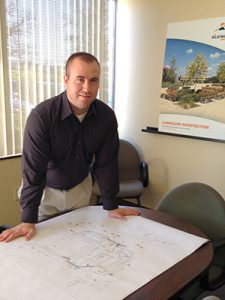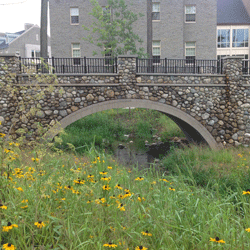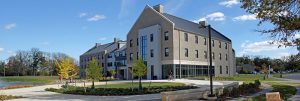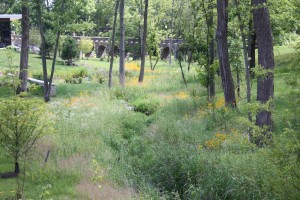The Kleingers Group Welcomes Josh Shaw to the Team
The Kleingers Group is pleased to announce Josh Shaw will be joining the team as a new project manager.
Shaw joins the Kleingers Group after 7 years in geotechnical engineering where his experience overlapped closely with many of the same architects, developers and municipalities with whom the Kleingers Group regularly works.
 “His experience managing projects and leading teams will dovetail nicely into his role as Project Manager at The Kleingers Group,” VP of Operations Steve Korte said. “He is well known in the industry and has already hit the ground running.”
“His experience managing projects and leading teams will dovetail nicely into his role as Project Manager at The Kleingers Group,” VP of Operations Steve Korte said. “He is well known in the industry and has already hit the ground running.”
Although his background has been in geotechnical engineering, Shaw said that since college he has always imagined himself eventually turning civil engineering into a career.
He decided to mention that passion to The Kleingers Group, which he knew to be the kind of firm where he wanted to work long-term, particularly because of its reputation as a family-oriented firm.
“I’ve always had a high regard for everyone at The Kleingers Group and I knew they had a strong reputation,” Shaw said. “I was looking for stability, for a firm I knew I could stay with for a long time.”
Shaw will join The Kleingers Group as a project manager in the Southwest Ohio Institutional Group, working under Korte. He will focus on a variety of site development projects in both Southwest Ohio and Northern Kentucky.
Shaw graduated from The Ohio State University with a Bachelor of Science in Civil Engineering and is a registered engineer in Ohio.
Kleingers awarded ‘Cincinnati Design Award’ for work at Miami
For the second year in a row, The Kleingers Group was the proud recipient of a Cincinnati Design Award in the landscape architecture category.
This year, Kleingers won the honor award for its work on Miami’s western campus.

The goal of the Cincinnati Design Awards is to recognize high-quality design in the regional community and to educate the general public about the benefits of supporting quality design. Kleingers was honored to be listed among the top designers in the region.
“We really enjoyed working with Miami and the project team and are really pleased with how well it all came together,” said Lynne Nischwitz, Kleingers’ Landscape Architecture Studio Leader. “We were especially proud of how the hardscape and softscape weave together and thought it was really spectacular that we were able to expand the University’s Horticulture Walk.”
At the event, the judges thanked Kleingers for creating such a pleasing landscape.
The project began in 2014 when the University constructed three new residence halls, a dining hall, a geothermal energy plant, and two ponds.
The University’s vision for the Western campus landscape was to create a cohesive, naturalistic, and sustainable landscape that would immerse students into nature. Kleingers worked closely with the University to bring the vision to life.
The final design expanded the University’s horticulture walk, provided a central large gathering space, passive gathering spaces for each residence hall, pedestrian connections across campus, stream restoration, and the new 150’ long bridge that will look like the historic, iconic cobblestone bridges that have existed on this portion of Miami’s Western campus for many years.

The landscape and hardscape spaces ‘weave together’ such that colorful naturalistic plantings danced into plaza areas while these plaza areas disintegrated into beautiful swathes of planting colors and textures. The interplay of movement between the prairie-style landscape and the hardscape plazas and walks unifies the entire Western campus landscape and indulges students and visitors in nature’s beauty.
Each area of the design was carefully thought out and plays a part in fulfilling the University’s vision.
New Plantings
The extensive and unique plant list includes native trees, ornamental grasses, and perennials that provide seasonal bloom and sweeping, dramatic, and naturalistic views. These plantings were extremely important to the University as they allowed for the expansion of the University Horticulture Walk.
Plantings include over 50 types of trees and a vast array of perennials and grasses. Trees included many Oak varieties such as Bur Oak, Sawtooth Oak, White Oak, Overcup Oak, Chinkapin Oak, Willow Oak, and Shingle Oak, as well as Shagbark Hickory, Dawn Redwood, Sycamore, Hardy Rubber Tree, Katsuratree, Cottonwood, Gingko, Black Tupelo, Amur Corktree as well as multiple Maple varieties to name a few. Ornamental grasses included Little Bluestem, Ice Dance Carex, Northern Sea Oats, and Autumn Moor Grass and perennials included Coneflower, Blazing Star, Russian sage, and Salvia and Sedum varieties.
Stream Restoration
The detailed design of the stream restoration creates dramatic views from the new and historic pedestrian bridges by creating pools of water in-between stream riffles. The naturalistic plantings along the stream contribute to the overall low maintenance field of native prairie grasses with pops of color. Boulders of varying colors were utilized at different points along the stream and positioned along strategic portions of the pond edge to further unify the western campus aesthetic and create rhythm with the architecture.

Large Gathering Spaces
The central large gathering space consists of a sunken lawn oval with amphitheater seating that diminishes into the ground, further enhancing the seamless transition of hardscape and softscape. This central gathering space provides the opportunity for organized concerts or casual use, allows for zero edge handicap accessible entry into the sunken ‘green’, and marries the hardscape and the residence hall architecture through rings of blue/black seeded aggregate that radiate out from the ‘central green’ oval and continue through the buildings and out into separate passive outdoor patio spaces.
Reviewed by a blind jury from all over the country, Kleingers was extremely honored to be recognized for its work creating a natural, cohesive and sustainable landscape.
Kleingers Trains Miami Students to Build Water Systems in S. America

For more than 13 years, Engineers Without Borders has been building engineering projects that empower communities to meet their basic needs.
With 300 chapters across the United States, more than 15,900 volunteers work together to provide engineering services and have impacted more than 2.5 million lives.
Mike Brunner, Water Resources Group Leader at The Kleingers Group, is currently acting as a mentor for the group, helping to train Miami University students who plan to travel to Ecuador, South America or Rwanda, Africa. Under the guidance of a mentor, the students will provide engineering services to build water systems that ensure the communities have access to water.
In late September, Brunner helped the students learn a variety of hands-on skills and the practice of engineering and surveying theory, including how to run an elevation level circuit, mix and place concrete, construct water piping systems, and test concrete beams.
Particularly popular was the process of breaking beams, which was done by having increasing numbers of students stand on the beams, which were positioned 3 inches off the ground until they broke. This was preceded by reviewing the design calculations and making predictions of how many students it would take to break them and how much they would deflect before breaking.
At an upcoming meeting this weekend, Brunner will help teach the student volunteers about building masonry walls.
Each training session prepares students for civil engineering, surveying, and other experience they may need on their upcoming trip.
“I had been looking for an organization like this, with an opportunity to give back and work with students for a long time,” Brunner said. “This really is a wonderful organization.”
Engineers Without Borders is organized by local chapters that partner directly with communities, mostly international, on projects to meet the community’s self-identified needs. The vast network of dedicated volunteers ranges from first-year engineering students and engineering professionals to public health professionals.
The over-arching philosophy of EWB-USA is to partner with communities in a sustainable way, and through the use of appropriate technology, so that they have ownership in the project(s) and will be able to maintain the project facilities long-term.
Along with two or three other local professional engineers, Brunner meets weekly with the student volunteers to provide advice and direction on the engineering/technical aspects of the project, as well as to guide them through the development of the project documents and EWB-USA paperwork.
Two different teams of Miami students from the chapter, along with a mentor, traveled to Ecuador and Rwanda last year to gather survey data that is being used to design the projects and to meet the local community leaders and citizens. Trips for the construction phase are being planned for this year.